
How to say 90 beautiful colors in Spanish (from purple to pastels)

Author
Learning the colors in Spanish should be one of the very first (and most enjoyable) tasks in every learner’s journey.
Not only will colors help you understand everyday conversations, but they’ll also help you become a more precise Spanish speaker. Even if you don’t consider yourself an artsy person, you’ll need colors to describe things around you: the trees, the animals, and even the big blue sea.
Whether you’re learning Spanish online for fun or want to do business with Spanish speakers, learning how to express yourself in Spanish color will drastically increase the quality of your interactions.
Let us walk you through our guide. We’ll cover (almost!) every color and, in the end, we’ll give you some helpful tips on how to memorize them. We’ll share some songs and even a few games that will make learning Spanish feel like a fun hobby.
Are you ready? ¡A estudiar los colores!
Download our free paper chatterbox to help you learn Spanish colors in no time!
Table of contents
- Why learn all the colors in Spanish?
- Colors in Spanish
- Free downloadable paper chatterbox
- Song about colors in Spanish
- Spanish colors FAQs
- A few extra tips for learning Spanish colors
Why learn all the colors in Spanish?
Before we dive in, we want to make sure that you’re fully on board with learning all the colors of the rainbow. Sure, you probably thought that at some point, you would just have to learn the colors, but let us give you a few reasons why this lesson is worth prioritizing now—no matter your stage in your learning journey!
Identify unknown objects
This is one of the biggest benefits of learning the Spanish colors early on. Need help identifying something whose name you don’t know? Ask your friend what that red thing over there is called! Need help ordering a specific flavor of ice cream from a nieve de garrafa spot in Mexico? Ask for a scoop of the coral-colored one right there!
If used appropriately, this strategy can help curious minds learn vocabulary that they see in everyday life. Just make sure not to over-rely on this, as it can quickly become a crutch. You don’t want to be asking for that yellow fruit at the market every time!
Speak more accurately
Knowing the different color shades will help you be more precise with your words. Maybe you don’t just want more salsa for your tacos—you want more salsa verde. Being able to use colors as adjectives will improve the accuracy of your sentences tremendously.
Make your learning experience more colorful
Okay, yes—it sounds a little cheesy. But it’s true! Spanish is a very colorful language, and being able to use colors to spice up your sentences will help you engage with it even more meaningfully, especially if you are learning Spanish for kids.
After all, Clifford is not just a big dog. He’s a big red dog. The same can be said for the Pink Panther, the Dr. Seuss book Green Eggs and Ham, and countless other characters and fictional story names. Colors can add a whole new layer to an already interesting story, so start using all the crayons in the box to color your sentences!
Colors in Spanish
Now, let’s get started! The first thing you will want to know is how to say the word ‘color’ in Spanish. Luckily, color is just color in Spanish! The only difference is the pronunciation: cuh-lore.
The word colors is a little bit different, as the singular color becomes the plural colores: cuh-lore-ehs.
You should also know that color is a masculine noun, so you would say el color and los colores.
Now that you’re familiar with the word color, it’s time to dig into los colores. Truthfully, you could learn the ten or so most common colors and do just fine, but that would be so boring. Who doesn’t love a burgundy sweater and looking at the lavender sky?
We will break down colors into different shades so that you have more tools to work with. We will also include the respective Spanish pronunciation so that you can pronounce them like a pro, even if you’re just getting started in your language-learning journey.
Without further ado, let’s get started!
Purple in Spanish
Purple comes in many unique shades that merit their own names. If you’re looking to describe a tasty Chilean wine or a beautiful Costa Rican sunset, you’ll want to know more than just purple in Spanish.
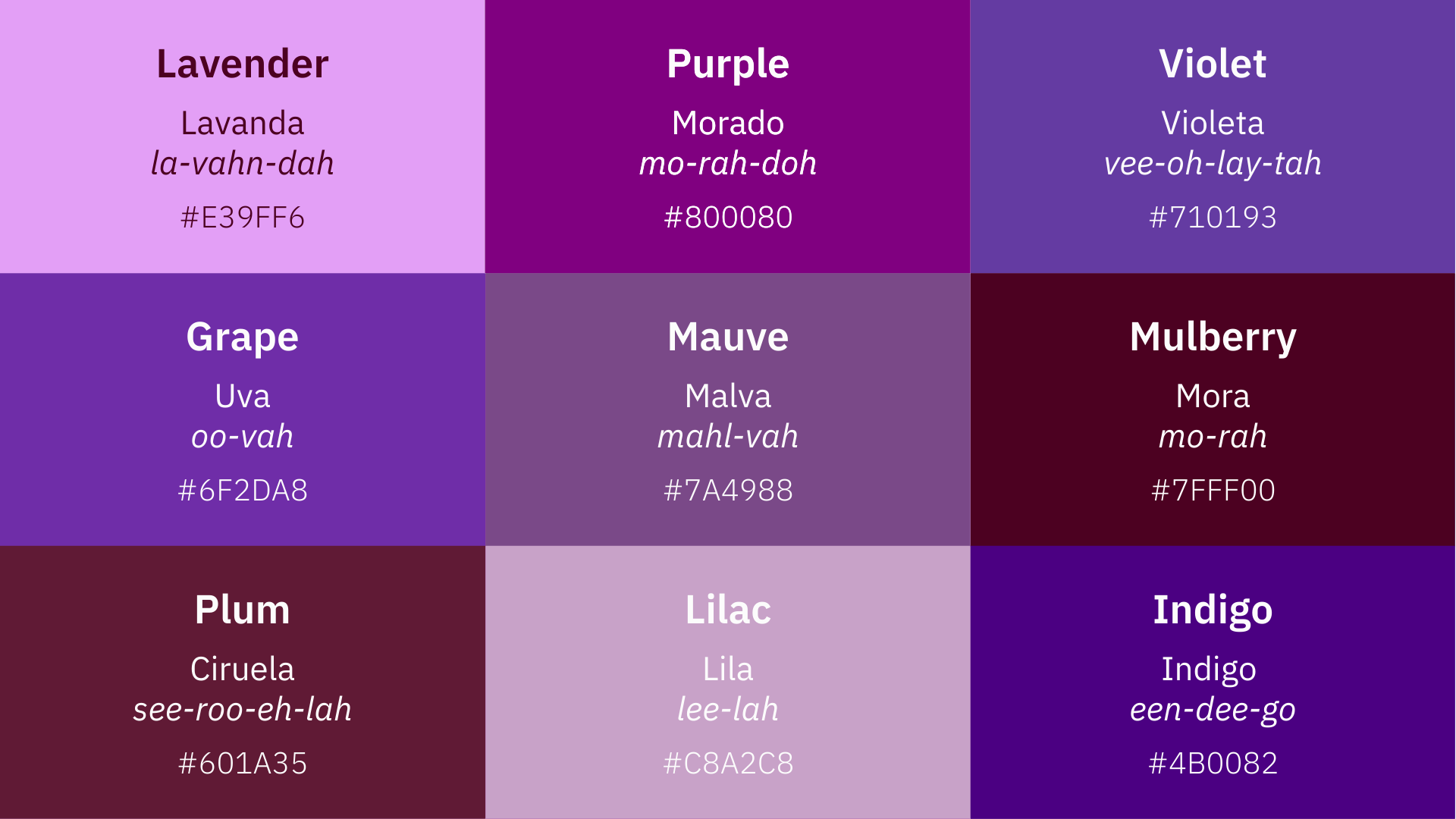
| English | Spanish | Pronunciation |
|---|---|---|
| Lavender | Lavanda | la-vahn-dah |
| Purple | Morado | mo-rah-doh |
| Violet | Violeta | vee-oh-lay-tah |
| Grape | Uva | oo-vah |
| Mauve | Malva | mahl-vah |
| Mulberry | Mora | mo-rah |
| Plum | Ciruela | see-roo-eh-lah |
| Lilac | Lila | lee-lah |
| Indigo | Indigo | een-dee-go |
Orange in Spanish
If you’re a bright and colorful person, you probably already say a lot of these shades of orange on a regular basis. Why not use them in Spanish as well? Go beyond just knowing how to say orange in Spanish and learn all about these beautiful shades.
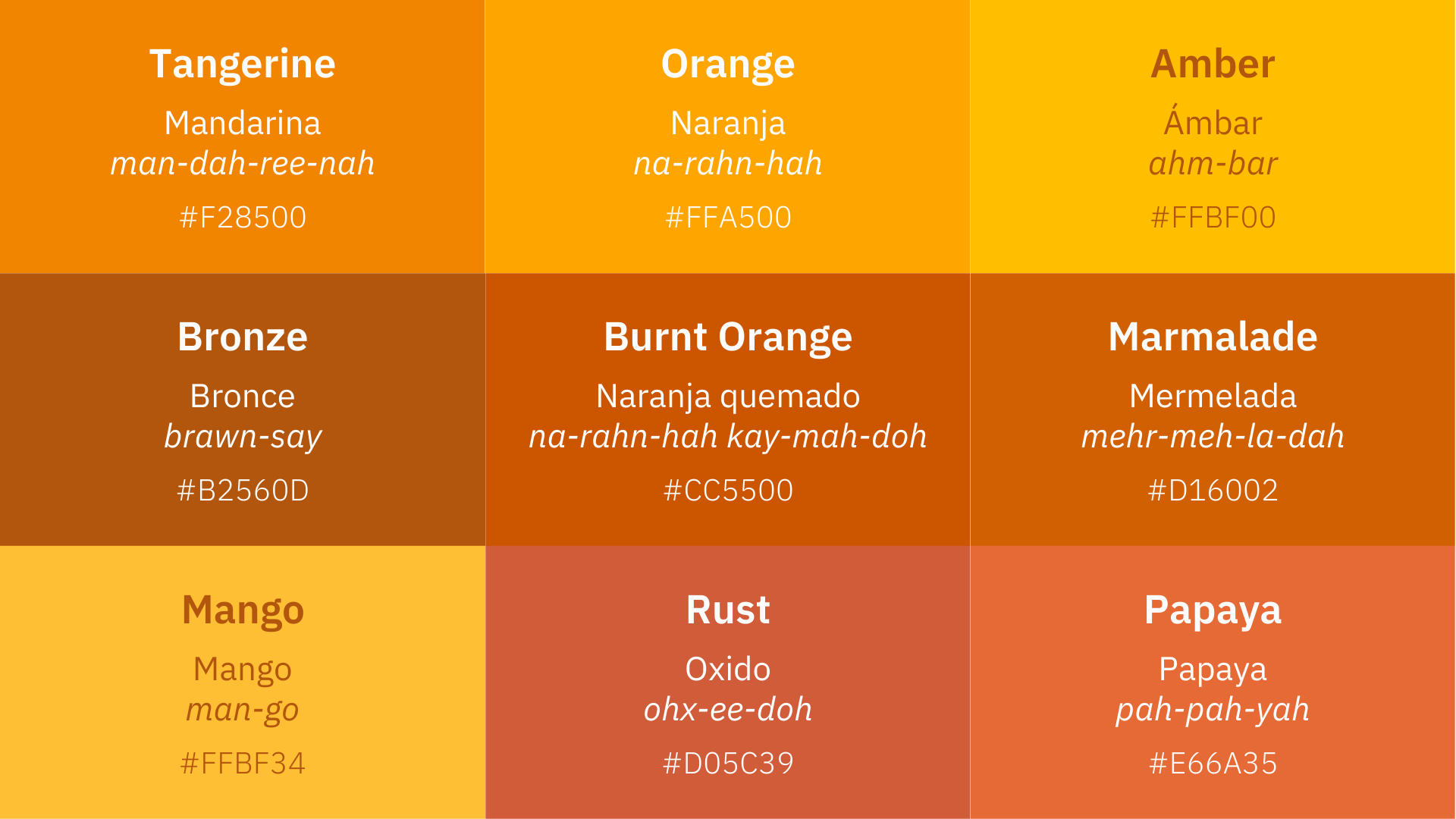
| Orange color variation in English | Color in Spanish | Spanish pronunciation |
|---|---|---|
| Tangerine | Mandarina | man-dah-ree-nah |
| Orange | Naranja | na-rahn-hah |
| Amber | Ámbar | ahm-bar |
| Bronze | Bronce | brawn-say |
| Burnt Orange | Naranja quemado | na-rahn-hah kay-mah-doh |
| Marmalade | Mermelada | mehr-meh-la-dah |
| Mango | Mango | man-go |
| Rust | Oxido | ohx-ee-doh |
| Papaya | Papaya | pah-pah-yah |
Blue in Spanish
Blue is one of the most interesting colors as it has many popular variations. Navy blue and turquoise are almost totally different colors, yet they’re both still blue. Learn how to say some of the most popular shades of blue in Spanish with our helpful table below.
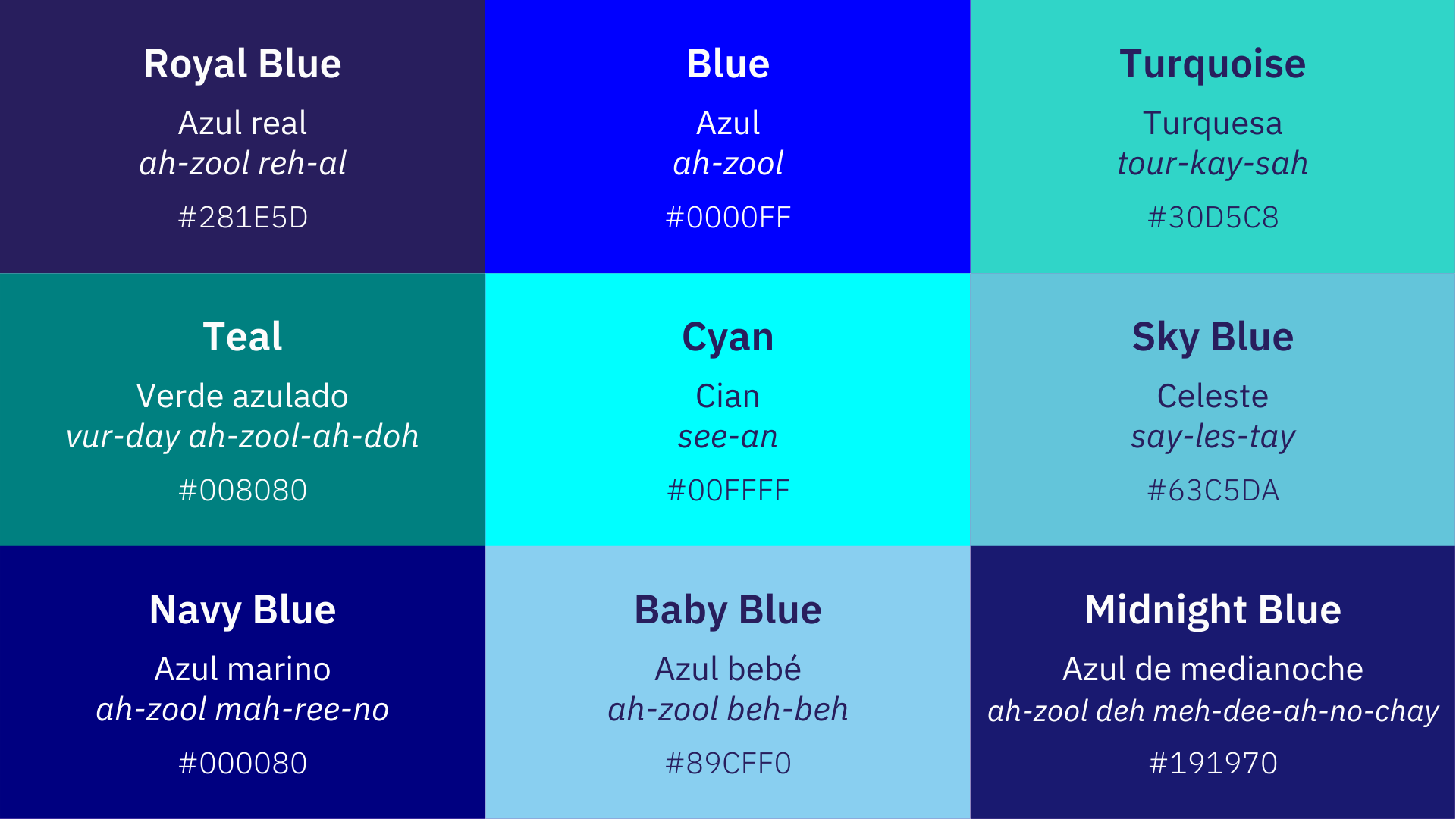
| English | Spanish | Pronunciation |
|---|---|---|
| Royal Blue | Azul real | ah-zool reh-al |
| Blue | Azul | ah-zool |
| Turquoise | Turquesa | tour-kay-sah |
| Teal | Verde azulado | vur-day ah-zool-ah-doh |
| Cyan | Cian | see-an |
| Sky Blue | Celeste | say-les-tay |
| Navy Blue | Azul marino | ah-zool mah-ree-no |
| Baby Blue | Azul bebé | ah-zool beh-beh |
| Midnight Blue | Azul de medianoche | ah-zool deh meh-dee-ah-no-chay |
Red in Spanish
Red is another color that comes with important shade variations. If you wear makeup, I’m sure you’ll find knowing how to say the different types of red in Spanish very helpful when looking for a new lipstick at the mall.
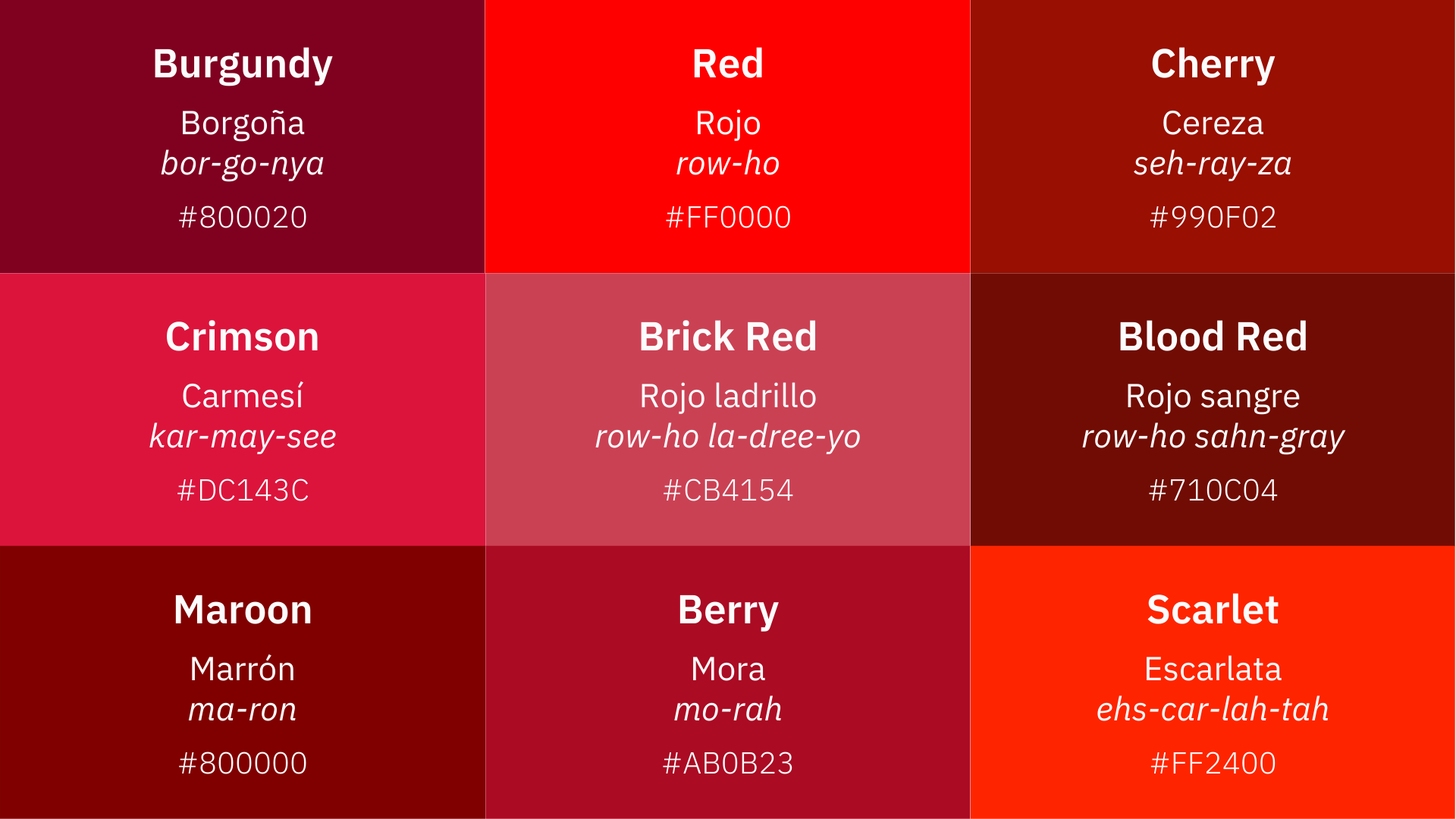
| English | Spanish | Pronunciation |
|---|---|---|
| Burgundy | Borgoña | bor-go-nya |
| Red | Rojo | row-ho |
| Cherry | Cereza | seh-ray-za |
| Crimson | Carmesí | kar-may-see |
| Brick Red | Rojo ladrillo | row-ho la-dree-yo |
| Blood Red | Rojo sangre | row-ho sahn-gray |
| Maroon | Marrón | ma-ron |
| Berry | Mora | mo-rah |
| Scarlet | Escarlata | ehs-car-lah-tah |
Yellow in Spanish
Yellow comes in many shades, from glistening gold to bright and fresh lemon. Being able to identify the different types of yellow in Spanish will help you when looking for a trendy mustard couch for your living room, or perhaps when picking out the perfect lemon meringue pie for a fabulous birthday party.
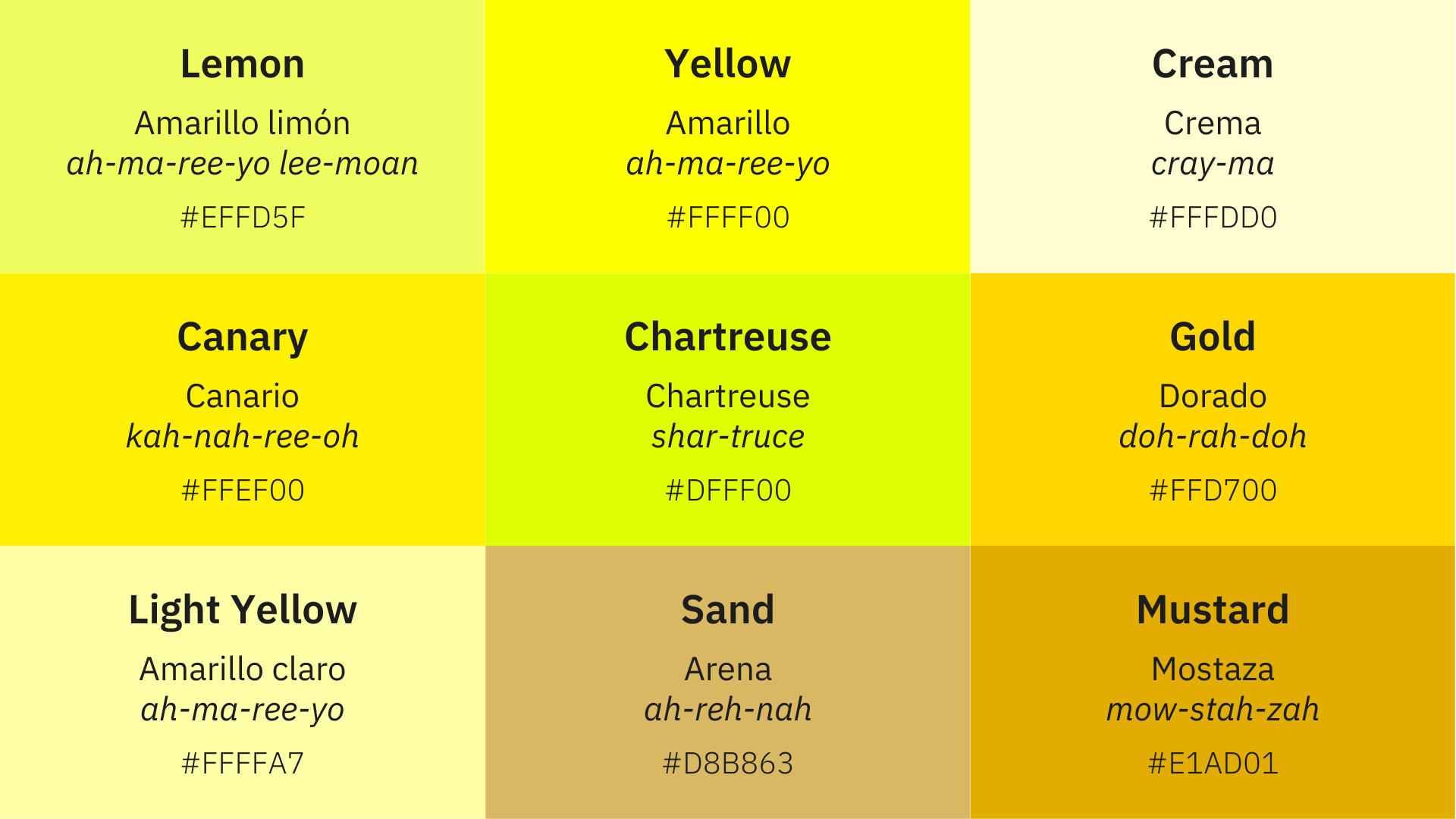
| English | Spanish | Pronunciation |
|---|---|---|
| Lemon | Amarillo limón | ah-ma-ree-yo lee-moan |
| Yellow | Amarillo | ah-ma-ree-yo |
| Cream | Crema | cray-ma |
| Canary | Canario | kah-nah-ree-oh |
| Chartreuse | Chartreuse | shar-truce |
| Gold | Dorado | doh-rah-doh |
| Light Yellow | Amarillo claro | ah-ma-ree-yo |
| Sand | Arena | ah-reh-nah |
| Mustard | Mostaza | mow-stah-zah |
Brown in Spanish
Brown is another very versatile color that can help you describe the things around you. Whether you’re trying to recall the name of an animal in Spanish or need help identifying a mouth-watering pan dulce (pastry) you had, knowing a few shades of brown in Spanish will be super helpful.
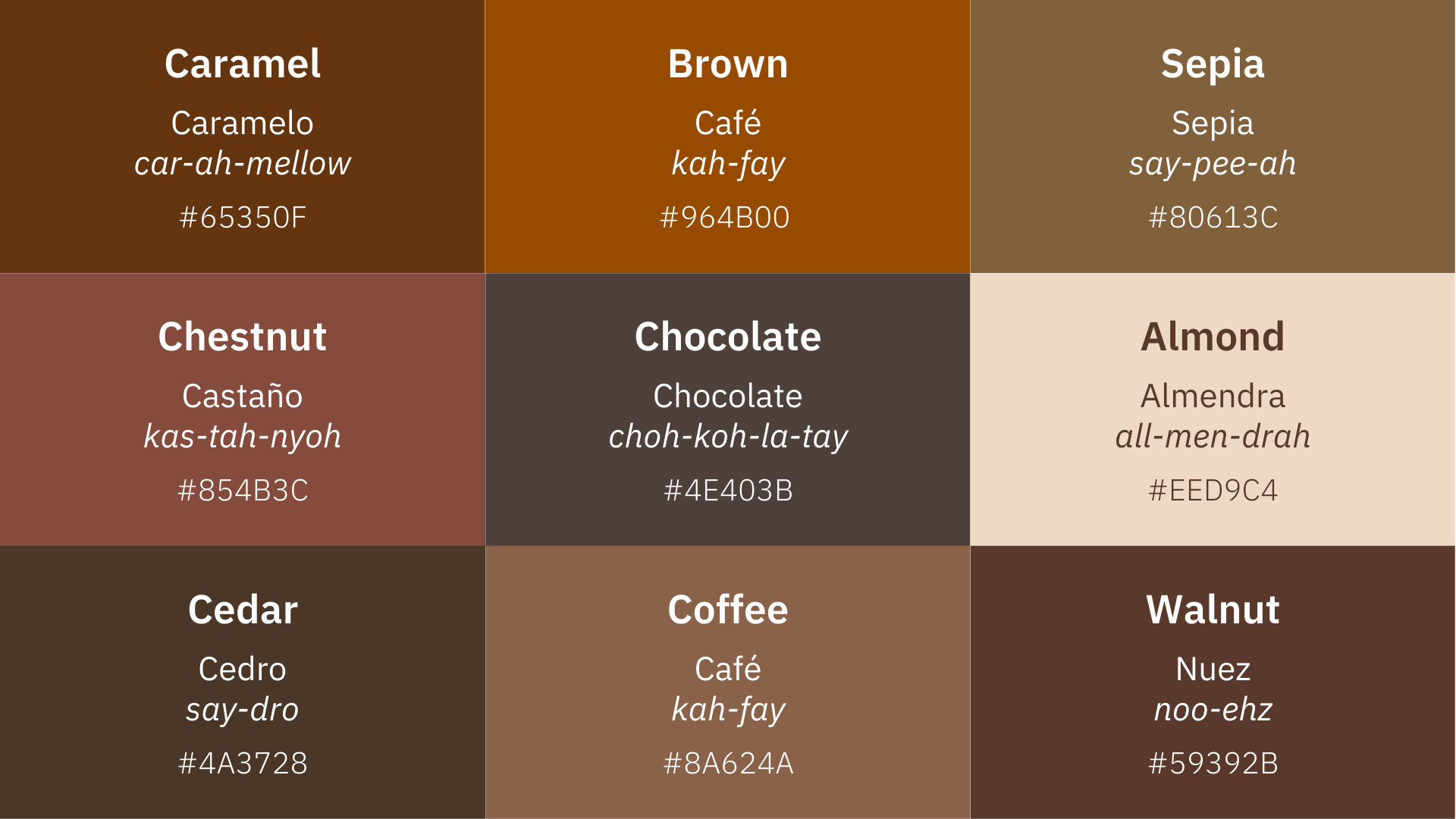
| English | Spanish | Pronunciation |
|---|---|---|
| Caramel | Caramelo | car-ah-mellow |
| Brown | Café | kah-fay |
| Sepia | Sepia | say-pee-ah |
| Chestnut | Castaño | kas-tah-nyoh |
| Chocolate | Chocolate | choh-koh-la-tay |
| Almond | Almendra | all-men-drah |
| Cedar | Cedro | say-dro |
| Coffee | Café | kah-fay |
| Walnut | Nuez | noo-ehz |
Pink in Spanish
You might find it interesting to note that pink has a complicated history of gendering.
Today, pink is a wonderfully diverse color that has become very popular for everyone. So, no matter what gender you identify with, or don't identify with, you are very likely going to find knowing how to say pink in Spanish very helpful!

| English | Spanish | Pronunciation |
|---|---|---|
| Peach | Durazno | doo-rahs-no |
| Pink | Rosa | row-sah |
| Coral | Coral | koh-rall |
| Rouge | Rouge | roosh |
| Magenta | Magenta | ma-hen-tah |
| Salmon | Salmón | sal-moan |
| Blush | Rubor | roo-bore |
| Hot Pink | Rosa intenso | row-sah in-ten-so |
| Strawberry | Rosa fresa | row-sah fray-sah |
Green in Spanish
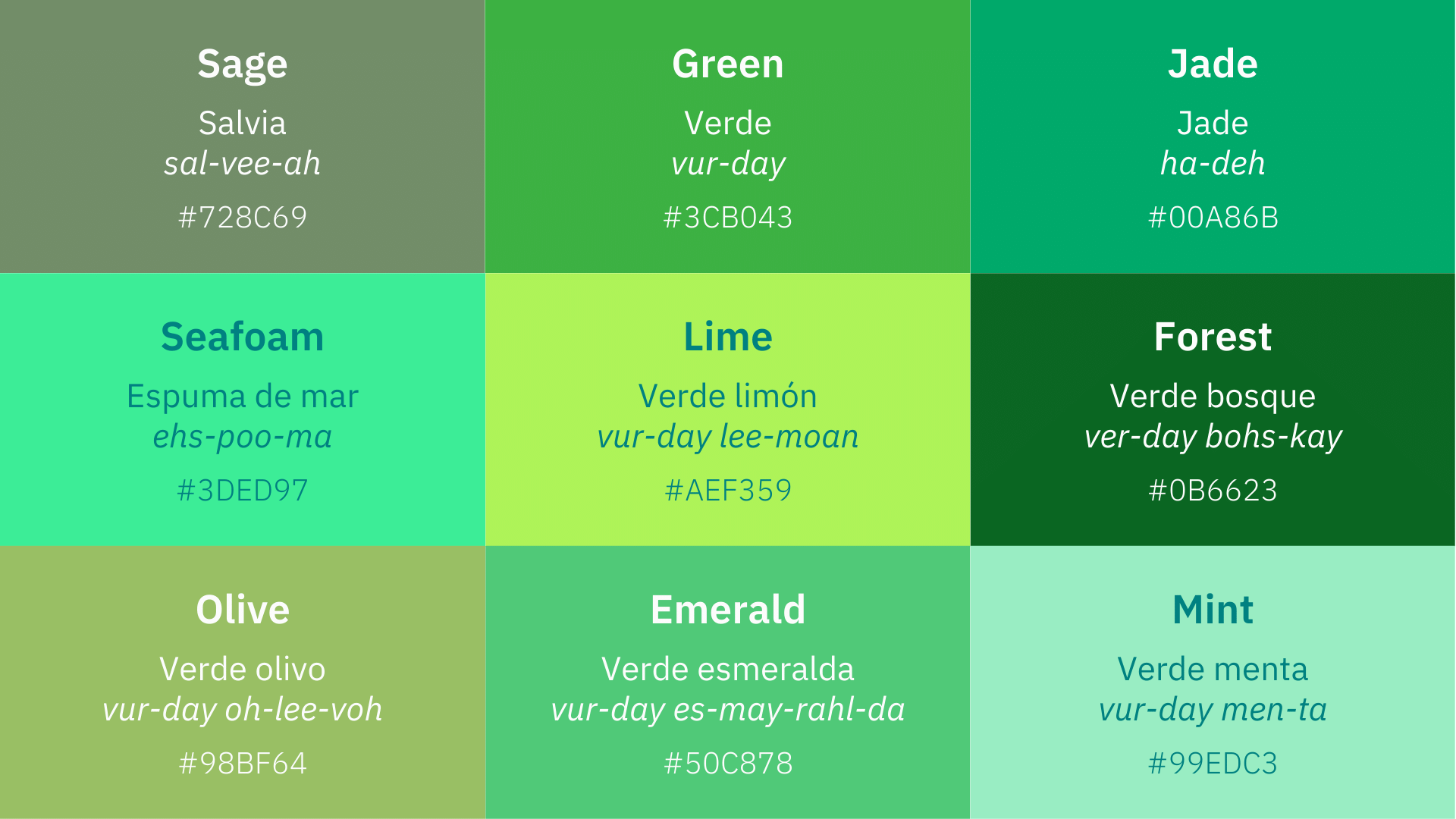
Knowing how to say green in Spanish is just not enough. Even just within nature, you wouldn’t use the same color to describe a fresh lime and centuries-old pine tree, right? Knowing just a few different types of green will help us be much more precise in Spanish.
| English | Spanish | Pronunciation |
|---|---|---|
| Sage | Salvia | sal-vee-ah |
| Green | Verde | vur-day |
| Jade | Jade | ha-deh |
| Seafoam | Espuma de mar | ehs-poo-ma |
| Lime | Verde limón | vur-day lee-moan |
| Forest | Verde bosque | ver-day bohs-kay |
| Olive | Verde olivo | vur-day oh-lee-voh |
| Emerald | Verde esmeralda | vur-day es-may-rahl-da |
| Mint | Verde menta | vur-day men-ta |
Black in Spanish
Although black is technically the absence of light, there are many different shades of black that can be helpful in everyday conversation. Knowing how to say a few different types of black in Spanish will be helpful if you’re online shopping for a new wardrobe or if you’re trying to buy a new car and want the paint and finish to be just right.
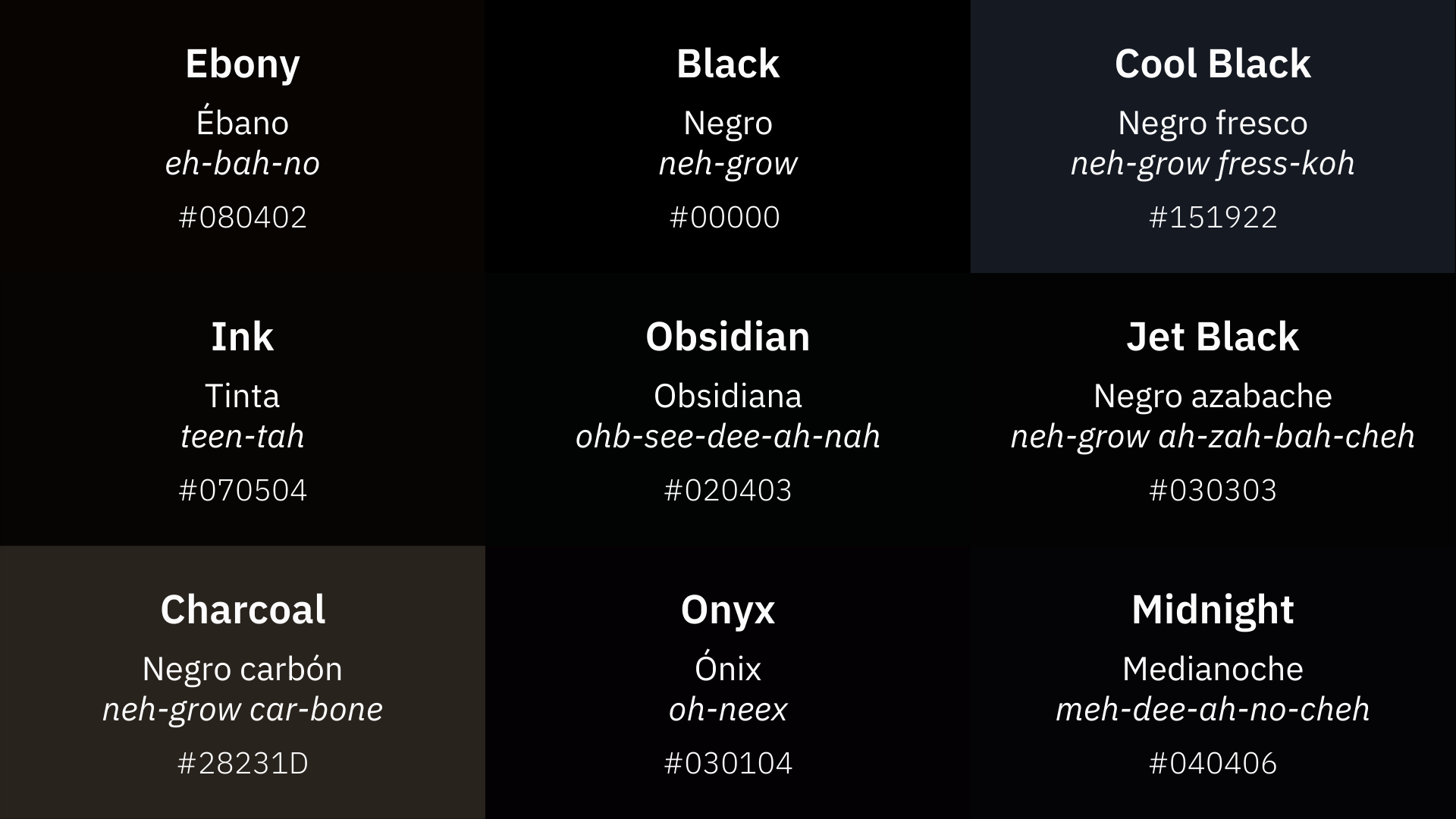
| English | Spanish | Pronunciation |
|---|---|---|
| Ebony | Ébano | eh-bah-no |
| Black | Negro | neh-grow |
| Cool Black | Negro fresco | neh-grow fress-koh |
| Ink | Tinta | teen-tah |
| Obsidian | Obsidiana | ohb-see-dee-ah-nah |
| Jet Black | Negro azabache | neh-grow ah-zah-bah-cheh |
| Charcoal | Negro carbón | neh-grow car-bone |
| Onyx | Ónix | oh-neex |
| Midnight | Medianoche | meh-dee-ah-no-cheh |
White in Spanish
Finally, we have white. Although white may seem like a very basic color, it actually comes in many beautiful shades that are very helpful for fashion, graphic and interior design. Here are some of the most popular shades of white in Spanish.
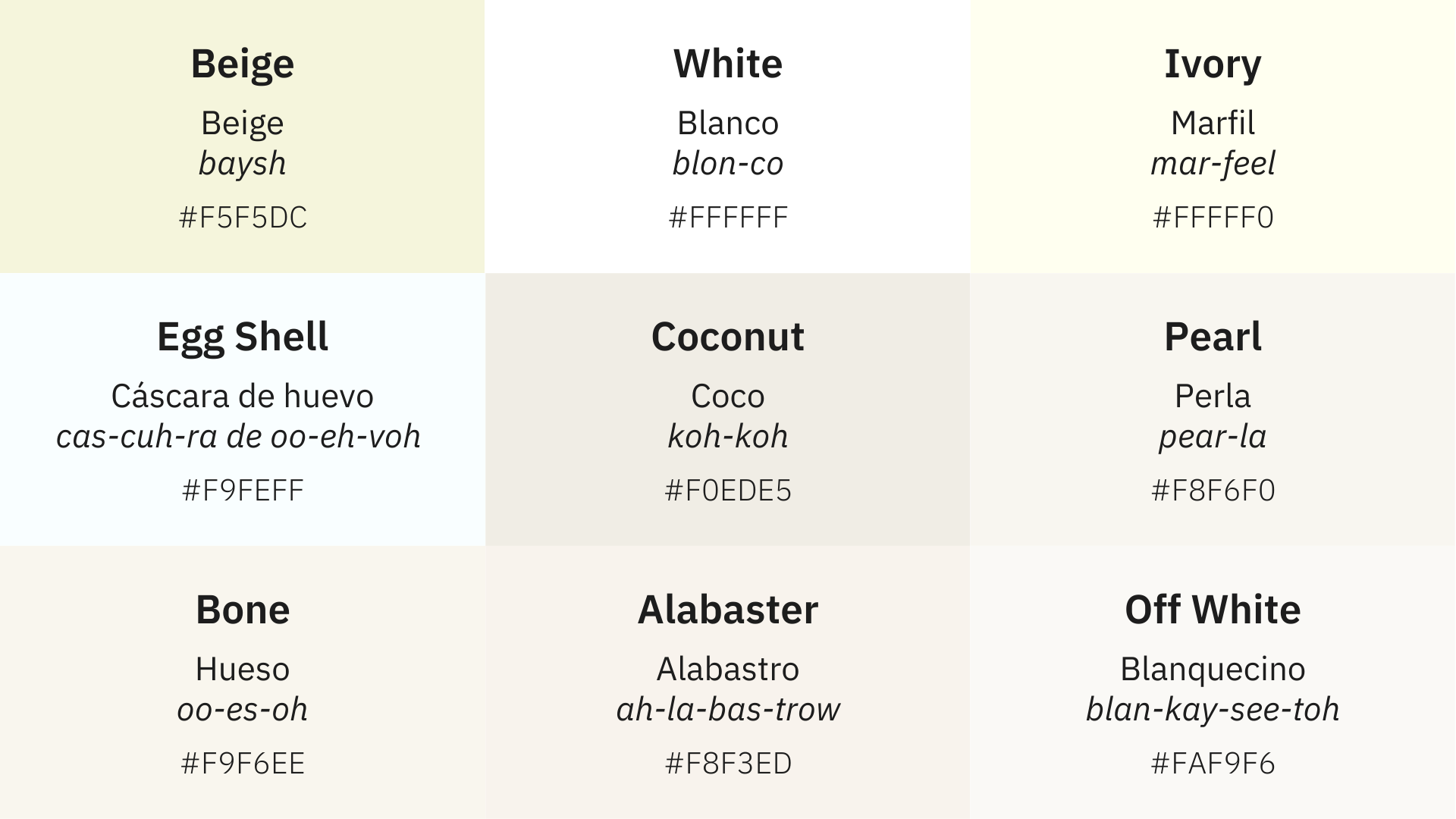
| English | Spanish | Pronunciation |
|---|---|---|
| Beige | Beige | baysh |
| White | Blanco | blon-co |
| Ivory | Marfil | mar-feel |
| Eggshell | Cáscara de huevo | cas-cuh-ra de oo-eh-voh |
| Coconut | Coco |
koh-koh |
| Pearl | Perla | pear-la |
| Bone | Hueso | oo-es-oh |
| Alabaster | Alabastro | ah-la-bas-trow |
| Off white | Blanquecino | blan-kay-see-toh |
Free downloadable paper chatterbox
This fun paper chatterbox will help you learn Spanish colors in no time! Our aim is to use both visualization and spelling techniques to help you remember the color names. Folding instructions are included on the pdf.
Song about colors in Spanish
Did you know that listening to music can be a great way to study? By listening to music while you relax or do some busy work, you can sneakily make your brain study for you.
Here are three great songs for different audiences. Pick any you like and feel free to browse YouTube and Spotify for other color-filled songs — you’d be surprised with how many great options there are!
The Colors in Spanish by Jack Hartmann
Most songs about colors are directed at kids. If you’re looking for a fun and upbeat song that will catch children's attention, then look no further. Whether you want it for your students or your kids, they are sure to enjoy learning the colors in Spanish with this great song.
Los Colores: The Colors in Spanish Song by Risas y Sonrisas
Teaching Spanish to your baby through nursery rhymes can be very effective. If you’re looking for ways to increase your child’s exposure to Spanish, this beautifully-soothing song will be fantastic for any young kid.
De Colores by Joan Baez
If you’re not really looking for songs for children and want something adults can enjoy, then De Colores by American folk singer Joan Baez could become a staple in your morning commute.
Spanish colors FAQs
Are colors in Spanish masculine or feminine?
All of them are masculine. Even if you think the color may be typically associated with feminine things, it will still be a masculine noun: el rosa, el lila, el violeta, just to name a few.
Things get a little tricky if you’re using a color as an adjective. In that case, you will have to slightly modify the gender of the color so that it matches that of the noun in question.
For example, you would say:
| Spanish | English |
|---|---|
| El carro rojo. | The red car. |
| La bicicleta roja. | The red bicycle. |
In the example sentences above, you have to change the ending of the color rojo so that the adjective agrees with the noun.
Are colors capitalized in Spanish?
Colors are not capitalized in Spanish unless they are the first word of a sentence or a part of a proper noun. Unlike languages like English or German, Spanish is very conservative with its capitalization rules. When in doubt, err on the side of not capitalizing the first letter of most words.
Can colors in Spanish be plural?
Yes they can be plural. For example, if you want to say ‘the shades of blue,’ you would say los tonos azules in Spanish. To make a noun plural, simply add an -s at the end of the word if it ends in a vowel or an -es if it ends in a consonant.
How do you say pastel colors in Spanish?
You can refer to pastels in Spanish as los colores pasteles. Just as in English, you can refer to a specific shade of a color by adding pastel to it: rosa pastel, verde pastel, amarillo pastel. Just be aware of word order, as the word pastel works as an adjective here and thus goes after the noun (which is the color in question).
How do you say primary colors in Spanish?
The primary colors in Spanish are called los colores primarios.
The primary colors are:
- rojo (red);
- verde (green); and
- azul (blue).
Their combinations create the colors:
- magenta (magenta);
- amarillo (yellow);
- cian (cyan); and
- blanco (white).
How do you say flying colors in Spanish?
If you’ve ever passed a test with flying colors, you might be wondering how to translate this idiom into Spanish. Unfortunately, there is no direct translation of this wonderful saying into Spanish. A close synonym would be to say “con gran éxito” after an action: aprobé el examen con gran éxito (I passed the exam with flying colors).
A few extra tips for learning Spanish colors
Post-it notes
This tried-and-true method for learning foreign language vocabulary can be especially helpful if you’re trying to identify colors. This trick is very simple: all you have to do is use small post-it notes to label different items in your room, kitchen, office, or anywhere you spend a lot of time!
The best part about this is that you can easily visualize the color. You don’t have to write down the translation on the post-it note, as you’ll be able to see the color of the item the note is on. Slowly, your brain will start to associate the different colors with the corresponding Spanish word.
Play color games
If you’re a dynamic learner, you can take advantage of interactive games to easily learn the various hues. Here are a few great ideas to get you started:
- Online Spanish colors games. If you’re solo, you might have to rely on computer games to learn the colors. RockAlingua has some great games that you can play on your web browser.
- Create Spanish coloring sheets. If you want your students to get engaged with the colors in a more literal way, you can always use crayons and coloring sheets! You could even use color-by-number sheets and pass around a color guide with only Spanish colors!
- Play color bingo. Who doesn’t love to play bingo? If you have a large enough group, you can create boards with different colors and set up for a fun time learning. Depending on the group’s level, you may choose not to include the names of each color on the cards. They will then have to pay close attention to which colors are called out!
Ready to fill your Spanish with color?
We hope you found this guide as inspiring as it is informative. Although there are many pragmatic reasons to learn the Spanish colors, we believe that knowing them can ultimately help you gain a different appreciation for the language.
Now that you know a wide range of colors, you can go out and express yourself much more beautifully in Spanish. Remember, the most important part of every learner’s journey is to keep moving forward, so don’t worry if you think you need more time to master the colors!
Slowly but surely, you will meet your language-learning goals. Get in touch with us if you’d like to chat about how we can help you get there, otherwise check out some more Spanish vocabulary blog article lessons here.



